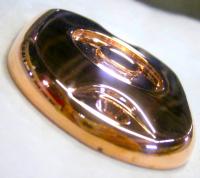
Photo from wikipedia
Benzotriazole (BTAH) and 2-mercaptobenzothiazole (MBT) are mixed to passivate electroplated copper coatings. The growth process of passive films is comprehensively analyzed from the surface potential, microstructure and chemical composition by… Click to show full abstract
Benzotriazole (BTAH) and 2-mercaptobenzothiazole (MBT) are mixed to passivate electroplated copper coatings. The growth process of passive films is comprehensively analyzed from the surface potential, microstructure and chemical composition by potential–time curve, FESEM and XPS. Meanwhile, the corrosion resistance of copper coatings with different passivation treatments is evaluated by potentiodynamic polarization curves and electrochemical impedance spectroscopy. During the composite passivation process of BTAH and MBT, the copper coating undergoes the following steps: chemical dissolution of the copper coating, preferential adsorption of MBT, formation of Cu(i)–BTA complex film and Cu2O, and synergistic growth of Cu(i)–BTA and Cu(i)–MBT. A protective film with a thickness of about 233 nm, containing the inner layer of BTA–Cu(i) and MBT–Cu(i) and the outer layer of MBT–Cu(i) and Cu2O, is formed on the copper coating after composite passivation. The composite passivation film significantly improves the corrosion resistance of copper coatings, and its corrosion inhibition efficiency for copper coatings reaches 90.7%, which is far better than that produced by using BTAH or MBT alone.
Journal Title: RSC Advances
Year Published: 2022
Link to full text (if available)
Share on Social Media: Sign Up to like & get
recommendations!